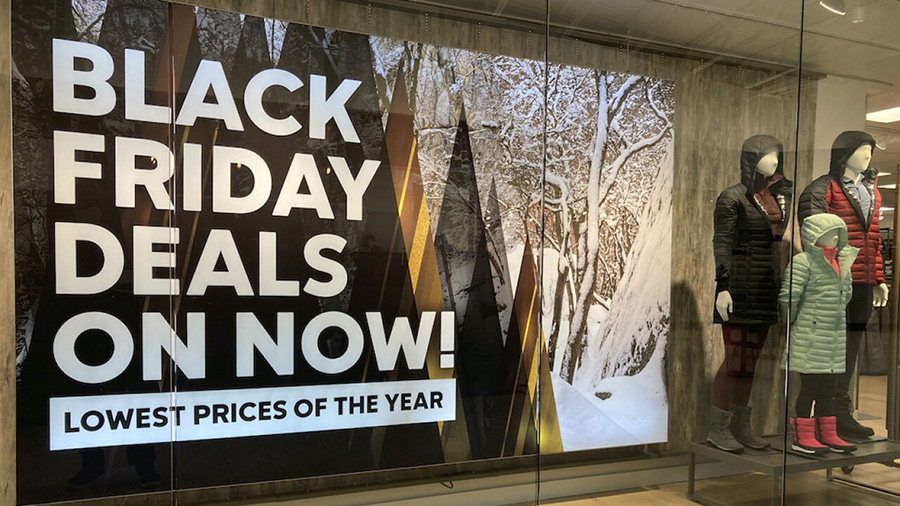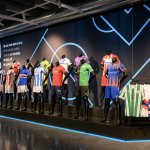Led by online selling and boosted by promotions, sales on Black Friday and over the past weekend topped or came in line with modest expectations, according to multiple survey reports and Wall Street analysts.
Holiday forecasters have widely forecasted that sales would slow back to pre-pandemic levels this year following pandemic stimulus-boosted gains in recent years and amid inflation and macroeconomic pressures. However, sales still grew over the last year, with promotions aligning with plans.
Both in-store and online retail sales increased year-over-year unadjusted for inflation, according to Mastercard’s SpendingPulse insights, which noted that apparel, jewelry and restaurant categories saw considerable spikes. Overall retail sales were up 2.5 percent year-over-year, excluding automotive. In-store sales climbed 1.1 percent, but e-commerce led the charge, up 8.5 percent, which Mastercard attributed in part to the number of sporting events airing during Black Friday. Mastercard said promotions worked to attract consumers to buy.
“Consumers are navigating the holiday season well and taking advantage of holiday promotions, giving them ample choice as they hunt for gifts for everyone on their list,” said Steve Sadove, senior advisor for Mastercard and former CEO and Chairman of Saks Inc. “Consumers are also shopping smarter, using all of their tools—from searching across channels to cross-checking on apps and websites—to maximize value while they spend time with friends and family.”
Adobe Analytics, which tracks U.S. online shopping, reported a record $9.8 billion spent on Black Friday sales, up 7.5 percent from 2022, driven by surging demand for electronics such as televisions, smartwatches and audio equipment.
Adobe found the online gains supported by heavy discounting. Sporting goods, for instance, saw a discount rate of 17.2 percent this year versus 6.3 percent on Black Friday in 2022. Apparel’s discount rate was 24.2 percent this year against 13.8 percent the prior year. However, the gains were also partly driven by net-new demand, not inflation-impacted higher prices as many analysts had feared, with Adobe’s Digital Price Index showing that e-commerce prices fell consecutively for 14 months (down 6 percent year-over-year in October 2023).
While Adobe does not adjust its figures for inflation, the company said that if it factored in online deflation, growth in consumer spend would be stronger.
“An uncertain demand environment pushed retailers to deliver big discounts this season while also fortifying their e-commerce services with flexible payment methods, better personalization and enhanced mobile functionality,” stated Vivek Pandya, lead analyst at Adobe Digital Insights. “Consumers have taken note and spent at record rates during the big shopping days, despite dealing with rising costs in other parts of their lives.”
Salesforce, which employs different metrics than Adobe, said it crunches numbers on transactions for some 1.5 billion consumers and reported that online sales grew 9 percent on Black Friday in the U.S. to $16.4 billion while increasing 8 percent globally to $70.9 billion. According to Salesforce’s findings, a record 79 percent of all shopping traffic, browsing and buying occurred on a mobile device.
“Black Friday online sales performance exceeded any retail executive’s expectations,” stated Rob Garf, VP and GM of Retail at Salesforce. “Retailers stepped up their discounting game and shoppers, in turn, clicked the buy button.”
Sensormatic Solutions, which tracks shopper traffic at brick-and-mortar stores, found shopper visits increased 4.6 percent at U.S. physical stores and shopping centers on Black Friday, representing a positive deviation from overall year-over-year performance, as traffic has been down 2.4 percent on average throughout 2023 to date.
“Our main takeaway from these results is their strength compared to previous years,” said Grant Gustafson, head of retail consulting and analytics at Sensormatic. “This is the most significant Black Friday increase we’ve seen in recent memory. It’s great news for retailers and consumers as we head into the remaining days of the holiday season.”
Looking ahead, Sensormatic said that while Black Friday is projected to be the busiest shopping day of the year, nine of the top 10 busiest days of 2023’s holiday season are still to come with those ten days expected to account for 40 percent of all holiday traffic. They’re also more concentrated toward the end of the year than usual, with Christmas falling on a Monday this year, according to Sensormatic. Super Saturday, the day before Christmas Eve this year, is expected to be the second-busiest day.
RetailNext found that footfall grew 2 percent year-over-year across the U.S., down from a jump of 7 percent in store traffic retailers saw last year. Retail verticals with the biggest footfall gains included health and beauty (traffic up 13.3 percent), jewelry (up 6.7 percent) and apparel (up 1.9 percent).
“This gives us a glimpse into the consumer mind, which is increasingly cautious about discretionary spending amid pressures like higher interest rates, student loan repayments, gas and grocery cost increases, increased credit card debt, and reduced savings rates,” said Joe Shasteen, global manager of Advanced Analytics at RetailNext in a statement. “With discounting at an all-time high this year, it’s likely the wider variety of discounted merchandise is boosting footfall as shoppers browse the best deals available. From a retailer’s perspective, discounting is giving their businesses the opportunity to reduce inventories and move product before the close of the year.”
Shopify said its merchants saw sales increase 22 percent on Black Friday on a global basis with a combined $4.1 billion in sales, with the e-commerce software platform declaring the performance “a strong start to the biggest holiday shopping weekend of the year.” The hottest product categories were clothing, personal care and jewelry.
“Another epic, record-breaking Black Friday in the books for Shopify merchants,” said Shopify President Harley Finkelstein in a blog post.
Among Wall Street analysts, Jim Duffy, Stifel’s lead analyst in the active lifestyle space, believes the generally favorable reads, particularly in online sales from third-party firms, show consumers are responding to deals and spending on gifts and in-demand items.
His team’s Black Friday and Cyber Monday brand/retailer checks show a “largely consistent promotional tone” versus 2022. Duffy said the exceptions where promotions were higher year-over-year were with brands weighted to cold weather merchandise, such as Columbia Sportswear and The North Face, and businesses that have prioritized inventory rationalization, including Clarus, Columbia, Hanesbrands, Under Armour, VF Corp., and Wolverine Worldwide. Duffy said, “With an additional weekend shopping day in Holiday 2023, we expect the market to maintain a promotional tone, but consumers shop later in the season looking for the best deals.”
Duffy favors stocks of brands that are maintaining a “largely full-priced posture,” citing On, Deckers Brands, parent of Hoka and Ugg, and Lululemon, as well as “those with compelling newness and promotions more shallow than the prior year,” citing Crocs and Kontoor Brands, the parent of Wrangler and Lee.
Tom Nikic, who covers Wedbush’s footwear and apparel space, said consumers appear “fairly resilient” despite the macroeconomic challenges, given the reports pointing to sales and traffic growth. However, he added that shoppers “did seem to be highly discount-focused and many of our brands/retailers were happy to oblige.”
Wedbush’s data on its tracked brands/retailers show that half were more promotional year-over-year, a quarter were similarly promotional versus last year and a quarter were less promotional
Nikic wrote, “Overall, we think that the brands that are best poised to succeed this holiday season are those that have had momentum on their side all year long. In other words, we think that the ‘winners’ will keep on winning, while it is a tough time for a brand or retailer to execute on a turnaround.”
Nikic said the “clearest winners” over Black Friday weekend appeared to be Deckers Brands and On. He observed, “Our checks uncovered strong demand trends, increasing shelf space, and minimal discounting for both rapidly-growing running-shoe brands, On and Hoka. We also believe that DECK’s Ugg brand continues to exhibit strong momentum.”
Wedbush’s checks also identified “good demand and reduced promotional activity” year-over-year for Crocs and Skechers. On the downside, Foot Locker was “unusually promotional.” Nikic also suspects brands, including Vans, owned by VF Corp., and Champion, owned by HanesBrands, that recently faced struggles “likely faced tough trends of late (including Black Friday week).” Those with “heavy exposure to the U.S. department store/mass channels” were also challenged.
Based on his team’s checks, BMO Capital Markets analyst Simeon Siegel said Black Friday weekend appeared to have largely played out on plan or better for many stores. He wrote, “Our store and online checks generally noted more, or flat, YoY [year-over-year] discounting, but promotional cadence that appeared in control and we’d expect mostly following plan.”
Paul Lejuez, at Citi Research, said traffic over Black Friday weekend (Friday to Sunday) was strong, up 3.5 percent over the same period last year, accelerating from recent weeks, according to ShopperTrak and Citi Research data.
Lejuez’s mall visits revealed store traffic lighter than expected on Black Friday, suggesting customers may have chosen to shop online. The analyst noted, “LULU, Old Navy, A&F, Hollister, and AE were the busiest stores we visited. Promos seemed broadly in-line to lower than last year, and clearance inventories/markdowns on clearance product seemed much lower than LY at most apparel retailers.”
A dimmer view came from Marshal Cohen, chief retail advisor at Circana, who lamented that Black Friday weekend missed the excitement of past years.
“Diluted by all the sales that started in mid-October and accelerated in early November, Black Friday weekend didn’t quite show its true color this year,” Cohen wrote in a blog post. “The big weekend’s deals were marginal. Doorbusters were generally absent, apart from a few rebate and coupon code offers. The occasional deep discount popped up, but most leveled out at 25 percent off.”
Cohen believes the “sense of urgency” was the biggest element missing from Black Friday events. He said, “Consumers had no worries about being able to get that hot product or limited-supply item (with the one exception of video game consoles).”
He believes that the better deals helped online performance, with online browsers able to search across sites better to ensure they received a compelling discount. Cohen said, “Layer on the increasing power of the younger generations and their propensity to shop online, and we have a new holiday shopping dynamic.”
















